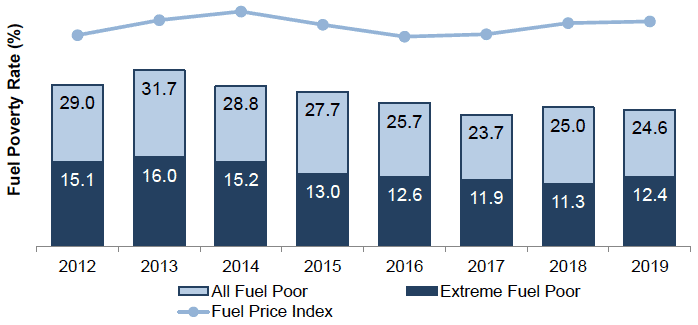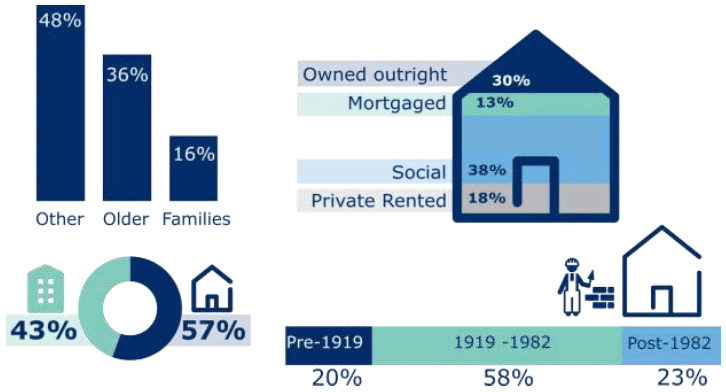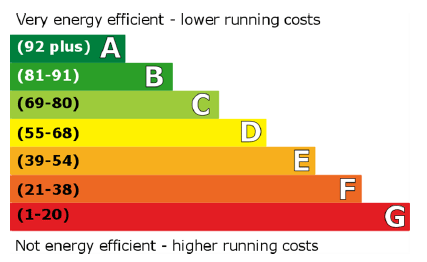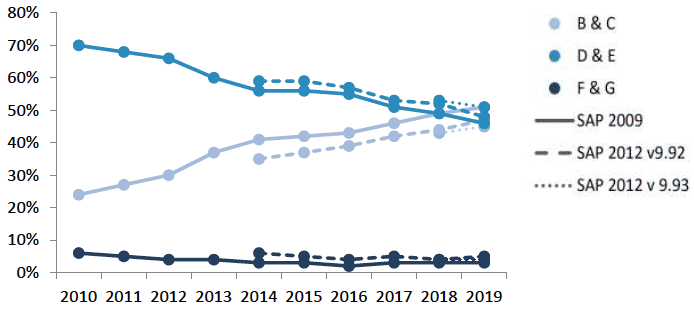Scottish house condition survey: 2019 key findings
Figures from the 2019 survey, including updated fuel poverty rates, energy efficiency ratings, the condition of housing and the Scottish Housing Quality Standard.
This document is part of 2 collections
Key Findings Summary
Fuel Poverty
- In 2019 an estimated 24.6% (around 613,000 households) of all households were in fuel poverty. This is similar to the 2018 fuel poverty rate of 25.0% (around 619,000 households) but lower than that recorded in the survey between 2012 and 2015.
- 12.4% (or 311,000 households, a subset of the 613,000 in fuel poverty) were living in extreme fuel poverty in 2019 which is similar to the 11.3% (279,000 households) in the previous year but a decrease from 16% (384,000 households) in 2013.
- The actual median fuel poverty gap for fuel poor households in 2019 was £750. This is higher than the median fuel poverty gap between 2015 and 2018. The median fuel poverty gap (adjusted for 2015 prices) for fuel poor households in 2019 (£700) is higher than in 2018 (£610) but similar to the median gap in 2012 to 2017.

Note: Energy requirement underpinning fuel poverty estimate modelled on the following basis: 2012 - 2013: BREDEM 2012 v.1.0; from 2014 onwards: BREDEM 2012 v.1.1, and New Prices to the adjustment of fuel price sources from 2013. From 2016 an improvement is included by assigning pre-payment metered fuel prices to the relevant households. From 2019 further improvements are included by using more detailed information on combi boilers to improve the accuracy of calculations surrounding hot water losses and assigning an off-peak tariff to relevant household's lights and appliances fuel prices.
Note: The 2012-2017 estimates are not comparable to those in the 2012-2017 Key Findings reports. See Section 4.1.1 for more details.
- Between 2018 and 2019, rates of fuel poverty increased in remote rural areas (from 33% to 43%), increasing the gap when comparing overall urban (24%) to overall rural areas (29%). Similarly, levels of extreme fuel poverty increased in remote rural areas (from 23% to 33%), meaning that extreme fuel poverty rates in rural areas (19%) were higher than in urban areas (11%).
- Overall rates of fuel poverty differed between the social (37%) and private sector (20%) although rates of extreme fuel poverty were similar (14% and 12%, respectively) in 2019.
- As in 2018, older households (27%) and other households (27%) in 2019 have a higher fuel poverty rate than families (17%).
- Levels of fuel poverty among households using electricity as their primary heating fuel have remained the highest, at 43%, compared to households using gas (22%), oil (28%) and other fuel types (31%) as their primary heating fuel in 2019.

- A higher proportion of households with a pre-payment meter (PPM; electricity, gas or both) were in fuel poverty compared to those without a PPM, 36% compared to 22% respectively.
- Fuel poverty and extreme fuel poverty have a strong association with income with rates increasing as weekly household income decreases. Extreme fuel poverty rates in the second lowest income band (£200-£299.99 a week) have increased in 2019 (25%) compared to 2018 (16%).
- Although low income is associated with fuel poverty, it is not equivalent. 73% of fuel poor households were also income poor in 2019 whilst the other quarter would not be considered income poor (27%). This is a similar pattern to 2018 (70% fuel and income poor and 30% fuel poor not income poor).
Heating Satisfaction
- Fuel poor households and extreme fuel poor households are more likely to have difficulties staying warm in winter and to report affordability problems; 23% of fuel poor and 28% of extreme fuel poor say that their heating keeps them warm enough in winter "only sometimes" or "never", compared to 15% of all other households. 9% of fuel poor and 10% of extreme fuel poor households report that they cannot afford to heat their home, higher than the 3% of non-fuel poor households.
- 13% of all households find that their heating keeps them warm enough in winter only sometimes and 3% find it never keeps them warm. This is similar to 2018 rates.
- The extent to which home energy use is monitored by householders is similar to last year with 57% stating they monitor their energy use "very" or "fairly closely" compared to 58% in 2018. 35% of all households report owning an energy monitoring device - a 7 percentage point increase on the previous year.
- A similar proportion of fuel poor (60%) and extreme fuel poor (59%) households monitored their energy use "very" or "fairly closely" compared to non-fuel poor households (56%) in 2019. However they are less likely to have monitoring devices at home; 32% of fuel poor and 28% of extreme fuel poor households compared to 36% of all other households.
Energy Efficiency and Carbon Emissions
- In 2019, 45% of Scottish homes were rated as EPC band C or better and half had an Energy Efficiency Rating of 67 or higher (SAP 2012 (RdSAP v9.93)) which is similar to 2018.
- SAP 2012 (RdSAP v9.92) allows consideration of trends over a longer period. 47% of Scottish homes were rated as EPC band C or better in 2019, a 3 percentage point increase on 2018 and an 11 percentage point increase from 2014 (the first year in which data based on SAP 2012 is available).
- Using SAP 2009 continues to show long-term improvement in the energy efficiency profile of housing. The share of the most energy efficient dwellings (rated C or better) increased from 24% in 2010 to 51% in 2019. In the same period, the proportion of properties in the lowest EPC bands (E, F or G) more than halved, reducing from 27% to 12%.


- The share of homes with lofts insulated to 100 mm or more remained at 94% in 2019. This represents an increase of 12 percentage points on 2010 levels although this has been stable since 2015. 30% of lofts were insulated to a high standard of insulation (300 mm or more), a similar level to 2015-2018 following significant increases from 5% in 2010.
- Wall insulation measures continue to be delivered under energy efficiency programmes such as the Energy Company Obligation (ECO). Levels of wall insulation have remained similar in recent years, with 59% of walls having insulation in 2019. However, there is a longer term trend of improvement with 18% of solid wall dwellings and 73% of cavity wall dwellings being insulated in 2019, representing an increase from 11% and 66% respectively in 2012.
- In 2019, 64% of gas and oil boilers met the minimum efficiencies specified by current Building Standards, similar to 2018 but a substantial increase from 30% in 2012.
- One third of dwellings had an Environmental Impact Rating in band C or better in 2019 (SAP 2012 (RdSAP v9.93)), this is similar to 2018. The mean rating was 61 and the median was 64, both of which lie in band D.
- Average modelled carbon emissions for all properties was 73 kg/m2 in 2019 which has been stable since 2017 following a decrease from 80 kg/m2 in 2014.
Housing Conditions
- Disrepair to critical elements, central to weather-tightness, structural stability and preventing deterioration of the property, stood at 52% in 2019. Less than half of these (19% of all dwellings) required urgent disrepair to critical elements and just 1% had extensive disrepair (covering at least a fifth of the element area) to critical elements.
- Overall, this is an improvement of 5 percentage points on 2018, when 57% of dwellings had disrepair to critical elements, with 20% having critical elements in urgent need of repair and, again, just 1% having extensive disrepair to critical elements. The 2019 rate has returned to a level similar to 2017 (50%).
- 18% of dwellings had disrepair only to non-critical elements, with 3% of dwellings requiring some urgent repair and 1% with extensive disrepair to non-critical elements, similar to 2018.
- Levels of damp and condensation were similar to those seen in 2018: 91% of properties were free from any damp or condensation.
- 2% (or 40,000) of all dwellings fell below the Tolerable Standard in 2019, similar to 2018. Longer term this represents an improvement of 2 percentage points since 2012.
- The Scottish Housing Quality Standard (SHQS) failure rate in the social sector was 41%, not allowing for abeyances and exemptions, which is similar to 2018. This has fallen from 60% in 2010. Failures of the Energy Efficient criterion were the biggest drivers of failures overall. In 2019, 31% of social sector properties did not meet the Energy Efficient criterion.
- SHCS surveyors may not always be able to identify the presence of cavity wall insulation. The Energy Efficient criterion failure rate in the social sector would be 14% if it is assumed that all social dwellings have insulated cavity walls where this is technically feasible. This, in turn, would lower the overall SHQS failure rate in the social sector to 28%.
- The failure rate in the private sector overall is similar to that seen in 2018 (44%, compared to 43%) and is also driven by failures of the Energy Efficient criterion. Nevertheless, whilst private owners and landlords are currently under no obligation to bring their properties up to this standard, long term improvement is being made in the private sector overall.
- The majority of dwellings falling below the SHQS failed on a single criterion; this accounted for more than 8 out of 10 failures in the social sector and overall.
- For 69% of social homes failing the SHQS this was due to falling short on a single one of the 55 elements which make up the standard. Most frequently these were cavity wall insulation, pipe and tank insulation, full and efficient central heating, effective loft insulation, at least six kitchen sockets, and safe common front and rear doors.
- In 2019 around 51,000 households lived in overcrowded accommodation (2%) under the bedroom standard, similar 2018.
- Around 918,000 (37%) households had one bedroom in excess of the minimum requirement under the bedroom standard. A further 812,000 (33%) households had two or more bedrooms in excess.
- Social sector tenants are more likely to live in accommodation which is at the level meeting the minimum requirements of the bedroom standard (53% compared to 20% in the private sector). Social sector tenants are also slightly more likely (3%) to live in accommodation which is overcrowded according to the bedroom standard than those households living in the private sector (2%)
Contact
There is a problem
Thanks for your feedback